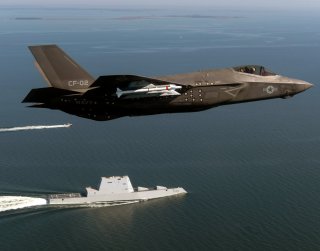Fight Smart: How the U.S. And Its Allies Can Blunt a Chinese Fait Accompli
A cursory look at the geography, surrounding force posture, and available assets in position suggest that a rapid, fait accompli takeover of Taiwan would be a realistic option for Beijing.
Dual-carrier operations, dispersed groups of heavily armed attack submarines, surveillance drones, Tomahawk-equipped destroyers, and a lethal carrier air wing are U.S. Navy assets potentially capable of stopping a Chinese attack on Taiwan or preventing one from ever happening through a visible, robust deterrence posture.
In recent years, several think tank studies have questioned whether Taiwan could quickly be taken over by China, creating a fait accompli where removing occupying Chinese forces by force could lead to catastrophic consequences.
However, could U.S., Japanese, South Korean, and Australian forces get to Taiwan fast enough during a Chinese attack? Could there be an effective, coordinated multi-domain response within the small time window afforded during a Chinese attack? How quickly would a Chinese attack be detected?
Perhaps this is why senior Pentagon leaders from Secretary Lloyd Austin to Air Force Chief of Staff Gen. Charles Brown, Army Chief of Staff Gen. James McConville, and the department’s “China Power Report” all specifically cite China as a “pacing” threat to the United States and its allies.
Much of this is widely discussed and well known, as many lawmakers, senior Pentagon leaders, and weapons developers consistently point to China’s hypersonic weapons progress, technologically sophisticated and growing navy, fifth-generation aircraft, growing nuclear arsenal, and two-million strong ground force.
The thinking may be that an extremely strong, full-scale deterrence posture might be the best option when it comes to stopping China.
A cursory look at the geography, surrounding force posture, and available assets in position to respond to a potential Chinese invasion of Taiwan suggest that a rapid, fait accompli takeover of the island would be a realistic option for Beijing.
This, however, presumes that U.S. and allied air forces, long-range weapons, and ship-launched assets were not able to thwart, slow down, or stop a Chinese air-sea attack before they would land on Taiwanese shores. Should that happen, the United States and its allies would of course face a much different scenario.
The best hope, if the United States decides to intervene, likely resides in an effective deterrence posture and the ability of the United States and its allies to leverage air superiority, forward, power-projecting forces such as carriers, and networked air and missile defenses to blunt an opening salvo of Chinese ballistic missiles fired at Taiwan.
The hope is that U.S. intelligence and allied surveillance in the form of undersea and aerial drones, submarines, and satellites might discover preparations for an invasion early enough to position a response.
Should allied air superiority be established quickly then there might be hope that a major invasion could be stopped before reaching Taiwan’s shores.
Given that Taiwan is merely 100 miles from mainland China, however, this is a tall order.
Should the answer be yes, they would need air and maritime superiority. An amphibious assault carrying large numbers of Chinese troops and heavy armor would need to be destroyed from the air to prevent a fait accompli.
Kris Osborn is the defense editor for the National Interest. Osborn previously served at the Pentagon as a Highly Qualified Expert with the Office of the Assistant Secretary of the Army—Acquisition, Logistics & Technology. Osborn has also worked as an anchor and on-air military specialist at national TV networks. He has appeared as a guest military expert on Fox News, MSNBC, The Military Channel, and The History Channel. He also has a Master's Degree in Comparative Literature from Columbia University.
Image: Flickr/U.S. Navy.

